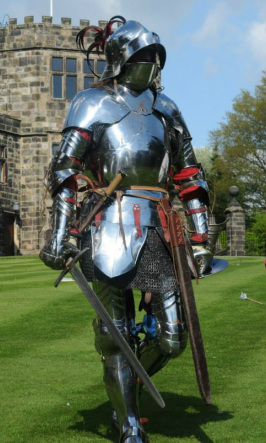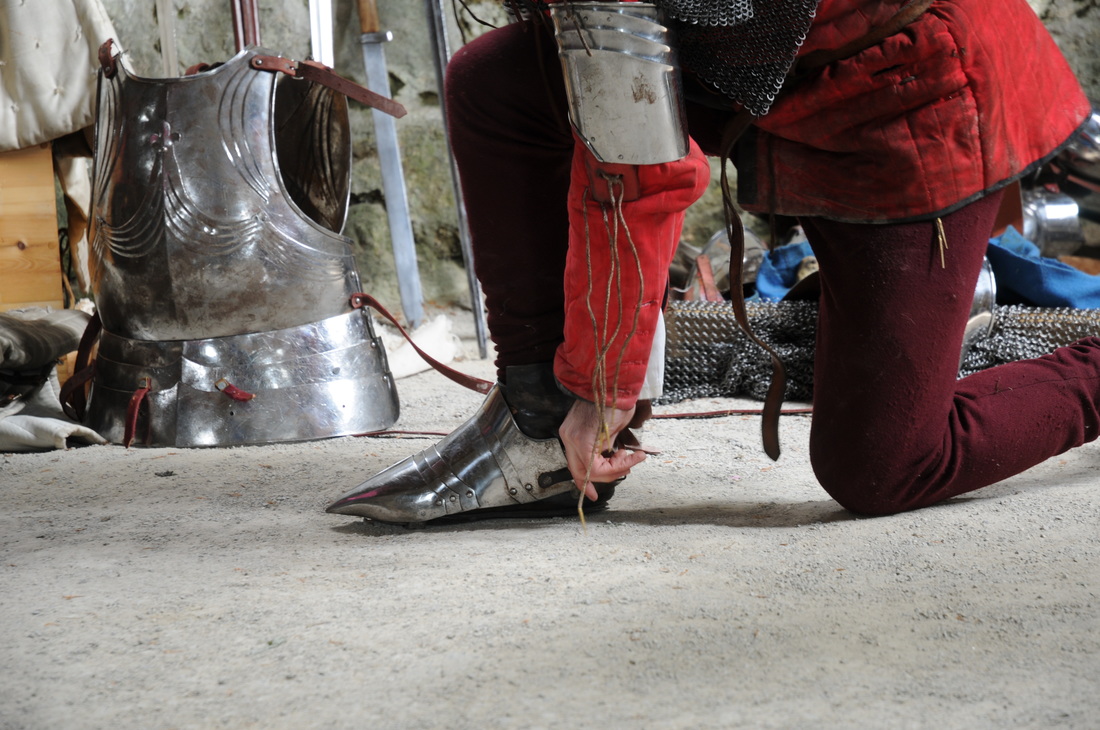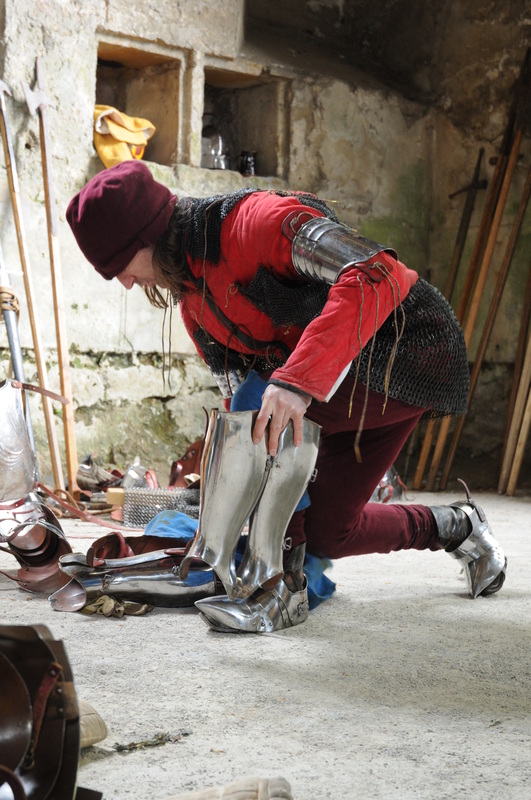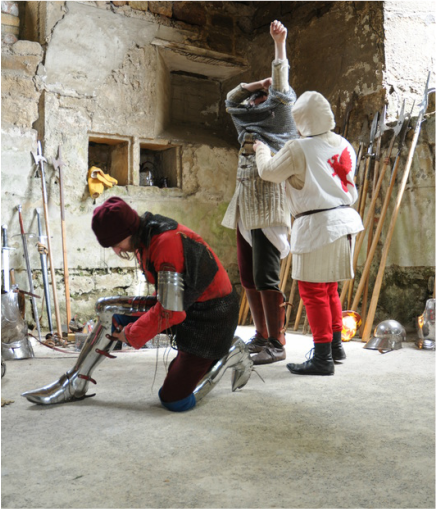The Armour of the Clifford Household.

Full Harness.
Firstly a note of caution. The subject of medieval plate armour is a vast and far reaching topic and many scholarly articles, books, television documentaries and missives have been written about its appearance, manufacture, use and social impact. This is no more than a cursory summary.
The armour and equipment of the knightly classes was always variable since it depended on personal wealth, preference, fashion and the skill of armourers. During the middle ages there was a gradual movement from the wearing of predominantly mail armour which was supplemented by a few items of steel plates to a predominantly steel plate armour supplemented by mail.
A full harness of steel plate armour was the ultimate goal of all the fighting gentry since it was both the pinnacle of protection that the armourers skill could provide and also highly fashionable. However, this came at a considerable cost and a fully articulated, bespoke, tailored suit of armour was out of the reach of many knights. Poorer knights would wear composite harness, which is another way of saying they wore a full harness that was not made as a complete harness, being made up of individual items sourced separately. They would have worn different elements of the full harness depending on personal preference and what they could afford. So it would have been typical to see a knight wearing a brigandine in place of a breastplate, an incomplete harness with elements of the arm or leg armour missing (or both) and larger elements of the steel plate armour substituted by maile.
A large amount of armour was also made ‘off the peg’ rather than ‘made to measure’ and the more wealthy noble lords would purchase this for their retainers. This also provided a cheaper alternative for those knights that could not afford the full time attentions of an armourer.
The general appearance of a full harness of armour depended on the style to which it was made and for The Wars of the Roses (the Cousins Wars) this can be usefully considered to be broadly related to three manufacturing centres:
Firstly a note of caution. The subject of medieval plate armour is a vast and far reaching topic and many scholarly articles, books, television documentaries and missives have been written about its appearance, manufacture, use and social impact. This is no more than a cursory summary.
The armour and equipment of the knightly classes was always variable since it depended on personal wealth, preference, fashion and the skill of armourers. During the middle ages there was a gradual movement from the wearing of predominantly mail armour which was supplemented by a few items of steel plates to a predominantly steel plate armour supplemented by mail.
A full harness of steel plate armour was the ultimate goal of all the fighting gentry since it was both the pinnacle of protection that the armourers skill could provide and also highly fashionable. However, this came at a considerable cost and a fully articulated, bespoke, tailored suit of armour was out of the reach of many knights. Poorer knights would wear composite harness, which is another way of saying they wore a full harness that was not made as a complete harness, being made up of individual items sourced separately. They would have worn different elements of the full harness depending on personal preference and what they could afford. So it would have been typical to see a knight wearing a brigandine in place of a breastplate, an incomplete harness with elements of the arm or leg armour missing (or both) and larger elements of the steel plate armour substituted by maile.
A large amount of armour was also made ‘off the peg’ rather than ‘made to measure’ and the more wealthy noble lords would purchase this for their retainers. This also provided a cheaper alternative for those knights that could not afford the full time attentions of an armourer.
The general appearance of a full harness of armour depended on the style to which it was made and for The Wars of the Roses (the Cousins Wars) this can be usefully considered to be broadly related to three manufacturing centres:
- German armour had a particularly gothic flavour to it, it was made symmetrically and featured decorative fluting designed to give strength to the armour as well as to make it look good. In particular the arms were made in three pieces that were tied onto the arming doublet.
- Italian armour was generally very butch looking and asymmetrical with a more heavily armoured left side. Arms were made as an articulated sleeve.
- English armour was somewhere between German and Italian but more akin to German armour in appearance. It was typically symmetrical since it was made for combat on foot (like the German) rather than mounted (like the Italian) and featured decorative fluting and folds to provide strength. However these were more organic in appearance, rather like vines on a tree than the gothic tracery of the German style.
The elements of armour that made up a full harness were (from bottom to top):
Sabaton – armoured feet, they generally followed the fashion for civilian footwear in style so in this period they had pointed toes. These could be very long, and detachable to help secure the foot into a stirrup and had detachable spurs.
Greaves – the lower leg defence that includes the shin to below the knee. This is a particularly difficult piece of the armour to make since it must accommodate the changing shape of the calf during movement.
|
Tasset – a plate of armour that hung from the torso armour to protect the gap between the top of the leg armour and the bottom of the fauld. This needed to be highly flexible to enable the wearer to sit comfortably (e.g. when riding).
Fauld – this was an articulated portion of the armour that sits at waist height and is attached to the plackart. The fauld was made up of articulated plates called lames that would allow the wearer to bend forwards/backwards.
Plackart – the lower part of the torso that covers the stomach which was a separate plate although joined to the:
Breastplate – the upper part of the torso that covers the ribs, lungs etc. This was joined to the plackart by leather straps and designed to ‘float’ within it so that the wearer had freedom of movement to twist and bend.
|
|
Gauntlets – armoured gloves either in the style of mittens or with individual armoured fingers.
Lower Cannon / Vambrace – the lower part of the arm armour that covered the forearm.
Couter – elbow defences.
Upper Cannon/ Rerebrace – the upper part of arm armour that covered the bicep/tricep.
Spaulder – a tight fitting shoulder defense usually an extension of the upper cannon where it rounds over onto the shoulder, not as large as:
Pauldron – Fairly large plates that covered the shoulder and wrapped over the back plate and breastplate to ensure the socket of the arm was fully covered.
Besagew – a disc or plate that covered the arm-pit and was typically worn with spaulders but not with a pauldron.
|









